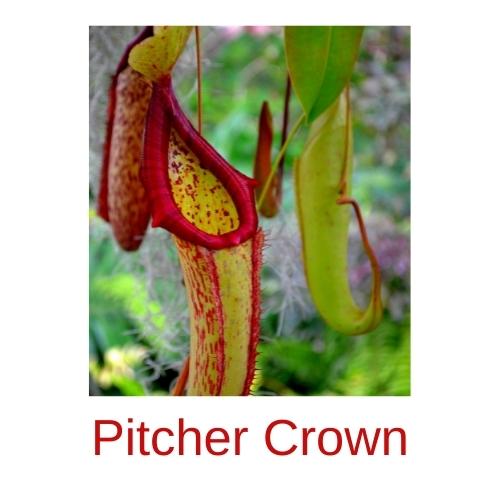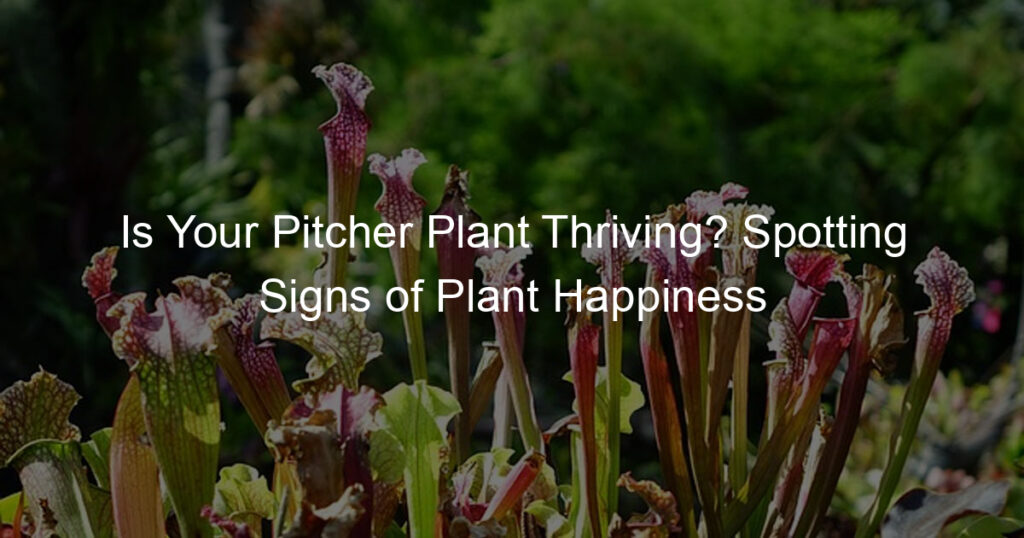
Introduction to Pitcher Plant Care
Welcome to our comprehensive guide on pitcher plant care. These unique and captivating plants require special attention and understanding to thrive. In this section, we will explore the unique needs of pitcher plants and the importance of regular health checks for your plant.
- Understanding the Unique Needs of Pitcher Plants
Pitcher plants are a fascinating group of carnivorous plants that have evolved to thrive in nutrient-poor environments. Unlike most plants, they obtain essential nutrients by capturing and digesting insects. This adaptation makes their care different from that of typical houseplants.
These plants require a humid environment, plenty of indirect sunlight, and a specific type of soil mix. They also need a dormant period during winter months for optimal growth. Understanding these unique needs is the first step towards successful pitcher plant care.
- Importance of Regular Health Checks for Your Pitcher Plant
Just like any other living organism, pitcher plants can experience health issues. Regular health checks are crucial to ensure your plant is growing well and is not suffering from any diseases or pests.
During these checks, you should look for signs of healthy growth such as new pitchers, vibrant color, and firm structure. Any changes, like browning leaves or a lack of new growth, could indicate a problem.
Regular health checks allow you to spot potential issues early and take corrective measures before they escalate. This proactive approach can make the difference between a thriving pitcher plant and one that’s struggling to survive.
Stay tuned as we delve deeper into the indicators of a healthy pitcher plant in the next section. We will also share best practices for pitcher plant maintenance and provide a closer look at the signs of a happy pitcher plant. By the end of this guide, you will be well-equipped to provide the best care for your pitcher plant.
Recognizing Healthy Plants: Key Indicators
Understanding the signs of a healthy plant is crucial for successful gardening. This knowledge allows you to quickly identify any issues and take appropriate action. In this section, we will focus on the key indicators of a healthy Pitcher Plant.
Signs of a Healthy Pitcher Plant
The Pitcher Plant, a fascinating carnivorous species, has specific signs that indicate its health. Let’s explore these indicators in detail:
- Healthy Coloration
- Stable Growth Rate
- Presence of Dew
The Pitcher Plant should have a vibrant green color, which is a clear sign of good health. Some varieties may also exhibit shades of red or purple. However, a dull or yellowish color might indicate a problem.
A healthy Pitcher Plant grows at a steady rate. While the growth rate may vary depending on the plant’s age and the season, sudden changes could be a sign of stress or disease.
The Pitcher Plant produces a sweet-smelling nectar or “dew” to attract insects. If your plant is dewy, it’s a good sign that it’s healthy and ready to feed.
Remember, every plant is unique and may show signs of health differently. The key is to observe your Pitcher Plant regularly and respond to any changes promptly.
Common Misconceptions About Pitcher Plant Health
When it comes to the health of pitcher plants, there are a few misconceptions that often lead to unnecessary worry or incorrect care. Let’s debunk two of the most common myths.
- Myth: Browning leaves always indicate a problem
- Myth: More water is always better
It’s a common belief that if the leaves of your pitcher plant are turning brown, it’s a sign of ill health. While browning can sometimes indicate an issue, it’s not always the case. Just like other plants, pitcher plants naturally shed older leaves, which turn brown before they fall off. This is a normal part of the plant’s life cycle and not a cause for concern. However, if you notice a sudden increase in browning or if the plant’s new growth also turns brown, it might be a sign of a problem such as overwatering or a lack of necessary nutrients.
Another common misconception is that pitcher plants need a lot of water. While it’s true that these plants thrive in humid environments, overwatering can actually harm them. Pitcher plants prefer damp, but not waterlogged, soil. Too much water can lead to root rot, a serious condition that can kill the plant. It’s important to maintain a balance – keep the soil moist, but make sure the plant has good drainage to prevent water from accumulating.
Understanding these misconceptions can help you provide the best care for your pitcher plant. Remember, every plant is unique and what works for one might not work for another. Always observe your plant’s behavior and adjust your care routine as needed.
Pitcher Plant Maintenance: Best Practices
Keeping your pitcher plant healthy and thriving requires a few key practices. Let’s delve into these essential tips for caring for your pitcher plant.
Caring for Pitcher Plants: Essential Tips
Here are three fundamental aspects to consider when caring for your pitcher plant:
- Proper watering techniques
- Choosing the right soil
- Understanding light requirements
Watering your pitcher plant correctly is crucial for its health. These plants prefer rainwater, distilled water, or reverse osmosis water. Avoid tap water as it may contain minerals that can harm the plant. The soil should always be damp, but not waterlogged. Overwatering can lead to root rot, a common issue with pitcher plants.
Pitcher plants thrive in nutrient-poor, acidic soil. A mix of sphagnum moss and perlite is often recommended. Avoid using standard potting soil or any soil with added fertilizers, as these can harm the plant.
Light is another crucial factor for pitcher plants. They need plenty of indirect sunlight. Too little light can cause the plant to become leggy, while too much direct sunlight can scorch the leaves. A north or east-facing window is often ideal.
By following these best practices, you can ensure your pitcher plant remains healthy and continues to thrive. Remember, pitcher plants are unique and require specific care compared to other houseplants. With the right care, these fascinating plants can be a delightful addition to your home.
Preventing Common Pitcher Plant Health Issues
Even the most robust pitcher plants can face health issues. However, with the right knowledge and preventive measures, you can keep your plant healthy and thriving. Let’s focus on two common issues: root rot and pests.
- Preventing Root Rot
Root rot is a common problem that can affect pitcher plants. It’s often caused by overwatering or poor drainage. The roots become waterlogged and start to decay, which can lead to the plant’s death if not treated promptly.
Here are some tips to prevent root rot:
- Ensure your plant’s pot has adequate drainage. This allows excess water to escape, preventing the roots from becoming waterlogged.
- Water your plant appropriately. Pitcher plants like moist soil, but not soggy. If the top inch of soil is dry, it’s time to water your plant.
- Use the right soil. A mixture of peat moss and perlite is ideal for pitcher plants as it retains moisture but also drains well.
- Managing Pests
Pitcher plants can also be affected by pests, such as aphids and mealybugs. These tiny insects can cause significant damage if left unchecked.
Here are some ways to manage pests:
- Inspect your plant regularly. Look for signs of pests, such as small, discolored spots on the leaves or a sticky residue on the plant or nearby surfaces.
- Isolate affected plants. If you notice pests on one of your plants, isolate it from your other plants to prevent the pests from spreading.
- Use a mild insecticide. If the infestation is severe, you may need to use a mild insecticide. Always follow the manufacturer’s instructions when using these products.
In conclusion, with the right care and attention, you can prevent common health issues and keep your pitcher plant in top shape. Remember, the key to a healthy plant is prevention!
Happy Pitcher Plant Signs: A Closer Look
Understanding the signs of a happy pitcher plant is essential for any plant enthusiast. These unique carnivorous plants have specific needs and show their satisfaction in distinct ways. Let’s delve into the key indicators of a thriving pitcher plant.
Spotting Signs of Plant Happiness
There are several signs that your pitcher plant is happy and healthy. These include active growth, healthy pitcher production, and consistent coloration. Let’s take a closer look at each of these signs.
- Active Growth
One of the most obvious signs of a happy pitcher plant is active growth. This means the plant is regularly producing new leaves and pitchers. If your plant is growing steadily and consistently, it’s a good sign that it’s getting the right amount of light, water, and nutrients.
- Healthy Pitcher Production
A healthy pitcher plant will produce a good number of pitchers. These are the plant’s unique, cup-like leaves that it uses to catch insects. If your plant is producing pitchers regularly, it’s a sign that it’s in good health. However, remember that pitcher plants have a dormant period in winter when they may not produce as many pitchers.
- Consistent Coloration
Consistent coloration is another sign of a happy pitcher plant. These plants should have a vibrant green color, with red or purple hues on the pitchers depending on the species. If your plant’s color is consistent and vibrant, it’s likely getting the right amount of light. However, if the color is fading or the plant is turning yellow, it may be a sign of too much direct sunlight or not enough nutrients.
In conclusion, spotting the signs of a happy pitcher plant involves observing the plant’s growth, pitcher production, and coloration. By understanding these signs, you can ensure your plant is thriving and adjust your care routine as necessary.
Case Study: Pitcher Plant Health Checks in Action
In this section, we will delve into two real-life case studies that illustrate the importance of regular health checks for pitcher plants. These examples will demonstrate how proper care and attention can revive a neglected plant and help a plant successfully transition to a new environment.
-
Case Study 1: Reviving a Neglected Pitcher Plant
Meet ‘Percy’, a pitcher plant that was found in a neglected state. Percy’s previous owner had not been providing the right care, resulting in a plant that was wilting and showing signs of distress.
After conducting a thorough health check, it was discovered that Percy was not receiving enough sunlight and was being overwatered. These are common mistakes that can lead to a pitcher plant’s decline.
With a change in care routine, including proper placement for optimal sunlight and a careful watering schedule, Percy began to show signs of improvement. Within a few weeks, new pitchers started to form, indicating that Percy was on the road to recovery.
This case study highlights the importance of regular health checks and the correct care routine for pitcher plants. It shows that with the right attention and care, even a neglected pitcher plant can be revived.
-
Case Study 2: Successful Transition to a New Environment
Our second case study involves ‘Pippa’, a pitcher plant that had to be moved from a humid, tropical environment to a drier, cooler one. This drastic change in environment could have been detrimental to Pippa’s health, but with careful monitoring and adjustments, the transition was a success.
During the transition, Pippa’s health was checked regularly. Adjustments were made to her care routine, including increasing the humidity around her and ensuring she was receiving enough warmth. Despite the change in environment, Pippa thrived and continued to grow new pitchers.
This case study shows that pitcher plants can adapt to new environments when given the right care. Regular health checks are crucial during such transitions to ensure the plant is adapting well and not showing signs of stress.
These case studies underscore the importance of regular health checks for pitcher plants. With the right care and attention, these fascinating plants can thrive, even under challenging circumstances.
Conclusion: The Joy of a Thriving Pitcher Plant
As we reach the end of our journey into the captivating world of pitcher plants, it’s time to reflect on what we’ve learned and why it matters. The joy of nurturing a thriving pitcher plant is a reward in itself, but it also offers a unique opportunity to witness the wonders of nature up close.
- Recap of key takeaways
- The importance of ongoing care and observation
Throughout this article, we’ve explored the essential aspects of pitcher plant care. We began with an introduction to these fascinating plants, highlighting their unique features and needs. We then delved into the key indicators of a healthy pitcher plant, from vibrant color to firm, upright pitchers.
We also discussed the best practices for pitcher plant maintenance, emphasizing the importance of proper watering, lighting, and feeding. We took a closer look at the signs of a happy pitcher plant, and we shared a case study that put these principles into action.
One of the most important lessons we’ve learned is that pitcher plant care is an ongoing commitment. These plants require regular attention and observation to ensure they’re thriving. By keeping a close eye on your pitcher plant, you can quickly identify any potential issues and take the necessary steps to address them.
Remember, a thriving pitcher plant is not just about its physical appearance. It’s also about its ability to capture and digest insects, its resilience against pests and diseases, and its capacity to adapt to changing conditions. By providing your pitcher plant with the care it needs, you can enjoy the satisfaction of watching it grow and flourish.
In conclusion, the joy of a thriving pitcher plant lies in the knowledge that you’ve played a part in nurturing a piece of nature’s wonder. It’s a testament to your patience, dedication, and love for these remarkable plants. So, keep learning, keep observing, and keep nurturing your pitcher plant. The rewards are well worth the effort.








